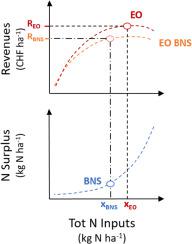Agricultural Systems ( IF 6.6 ) Pub Date : 2022-07-09 , DOI: 10.1016/j.agsy.2022.103451 F. Argento , F. Liebisch , T. Anken , A. Walter , N. El Benni

|
CONTEXT
Reducing N surplus from agriculture without compromising yield and quality requires economically and ecologically viable solutions.
OBJECTIVE
Based on field data, we investigated a technical and market-based solution to balance the economic and environmental performance of nitrogen (N) fertilizer application in winter wheat in Switzerland.
METHODS
The technical solution, i.e. variable rate (VR) technology, was compared to the standard uniform fertilizer application (ST) in terms of revenues and N balance over seven site-years between 2018 and 2020. The potential of a market-based solution to align revenues and N surplus was investigated based on the relationship between two indicators: the economic optimum (EO) of the revenues and the balanced N supply (BNS). The EO was estimated using a production function approach. The BNS was empirically defined as the point at which the N surplus estimated from total N input (N fertilizer + soil N supply) reaches a limit value of 30 kg N ha−1.
RESULTS AND CONCLUSIONS
On average, the revenues of VR were about 4% higher than in ST. The N surplus was, on average, 32% (21 kg N ha−1) lower in VR compared with ST due to a 13% reduction in N inputs with no significant differences in yield. Despite the differences across years and fields, VR appeared to be reducing N surplus without losses in revenues in 5 out of 7 site-years. The revenue curve reached an EO at total N input of 205, 249 and 246 kg N ha−1, in the years 2018, 2019, and 2020, respectively. The BNS was calculated at 220, 195, and 178 kg N ha−1 N inputs for the years 2018, 2019, and 2020, respectively. The results show that a price increase of up to 5.4 times the current fertilizer price through taxes would be necessary in order to reduce the N surplus to an environmentally friendly level. Such an increase would hardly be politically feasible.
SIGNIFICANCE
The reported data showed that VR technology appears as a viable solution for producing lower N surplus at comparable revenue levels, thereby making it an option for small- to medium-scale winter wheat production in Switzerland. The environmental benefit could encourage the financial support of technologies for precise N management, which are often too expensive for these systems. Future research should verify or extend the numeric values found in this study.
中文翻译:

研究平衡瑞士冬小麦收入和氮过剩的两种解决方案
语境
在不影响产量和质量的情况下减少农业氮过剩需要经济和生态上可行的解决方案。
客观的
根据现场数据,我们研究了一种技术和基于市场的解决方案,以平衡瑞士冬小麦施氮 (N) 肥料的经济和环境绩效。
方法
在 2018 年至 2020 年的 7 个地点年的收入和氮平衡方面,将技术解决方案(即可变速率 (VR) 技术)与标准均匀施肥 (ST) 进行了比较。基于市场的解决方案的潜力基于收入的经济最优(EO)和氮平衡供应(BNS)两个指标之间的关系,研究了收入和氮过剩。EO 是使用生产函数法估算的。BNS 在经验上被定义为从总氮输入(氮肥 + 土壤氮供应)估计的氮过剩达到 30 kg N ha -1的极限值的点。
结果和结论
平均而言,VR 的收入比 ST 高出约 4%。与 ST 相比,VR的 N 盈余平均低 32%(21 kg N ha -1),这是因为 N 投入减少了 13%,而产量没有显着差异。尽管年份和领域之间存在差异,VR 似乎在 7 个站点年中有 5 个在没有损失收入的情况下减少了 N 盈余。收入曲线在 2018 年、2019 年和 2020 年的总氮输入量分别为 205、249 和 246 kg N ha -1时达到 EO。BNS 在 220、195 和 178 kg N ha -1下计算 分别为 2018 年、2019 年和 2020 年的 N 个输入。结果表明,为了将氮过剩减少到环境友好的水平,有必要通过税收将价格提高至当前肥料价格的 5.4 倍。这样的增长在政治上几乎是不可行的。
意义
报告的数据显示,VR 技术似乎是一种可行的解决方案,可以在可比的收入水平下生产较低的氮过剩,从而使其成为瑞士中小型冬小麦生产的一种选择。环境效益可以鼓励对精确氮管理技术的财政支持,这对于这些系统来说通常过于昂贵。未来的研究应该验证或扩展本研究中发现的数值。



























 京公网安备 11010802027423号
京公网安备 11010802027423号